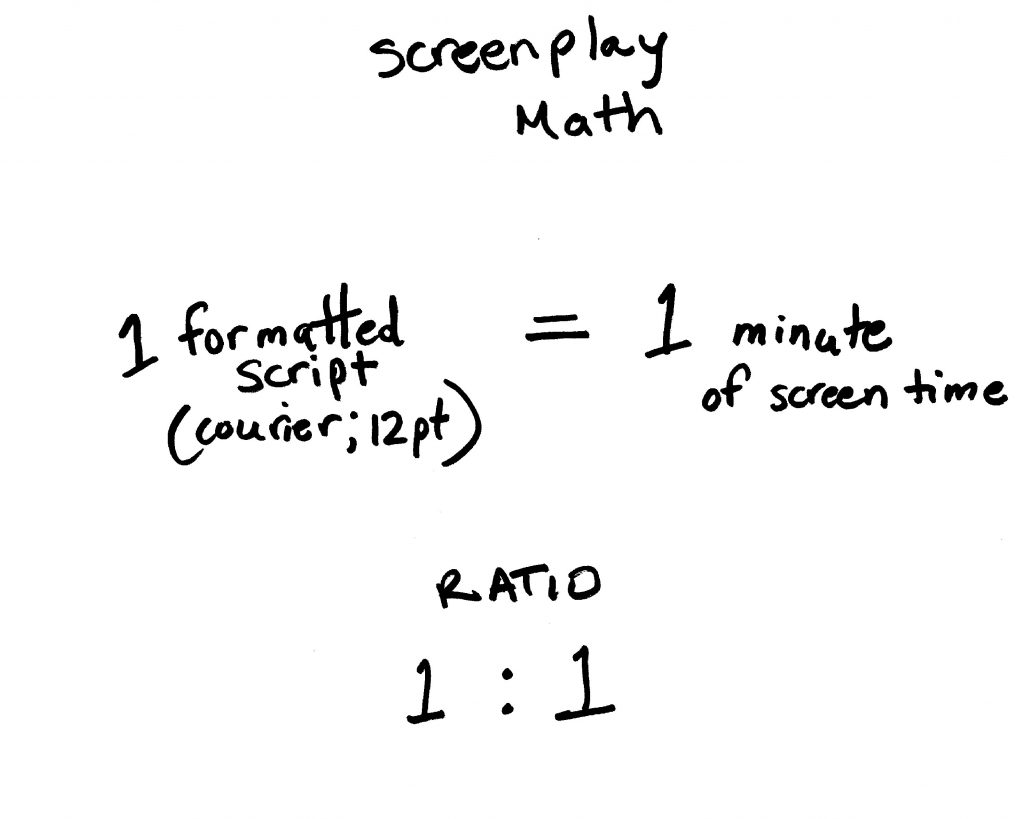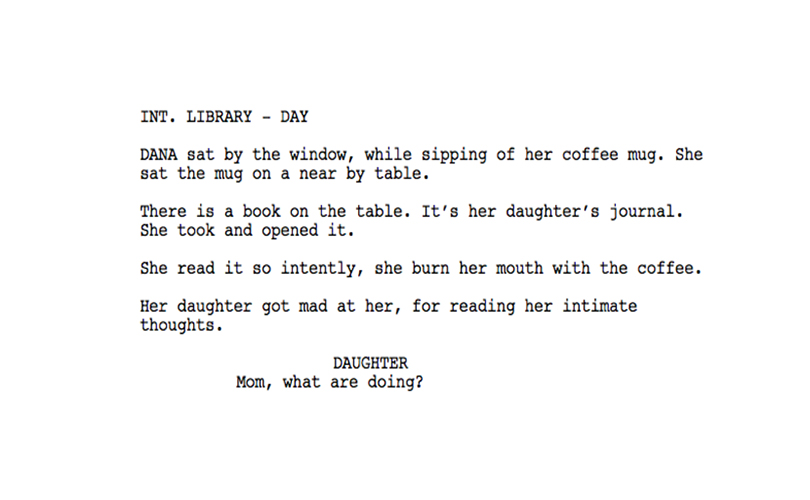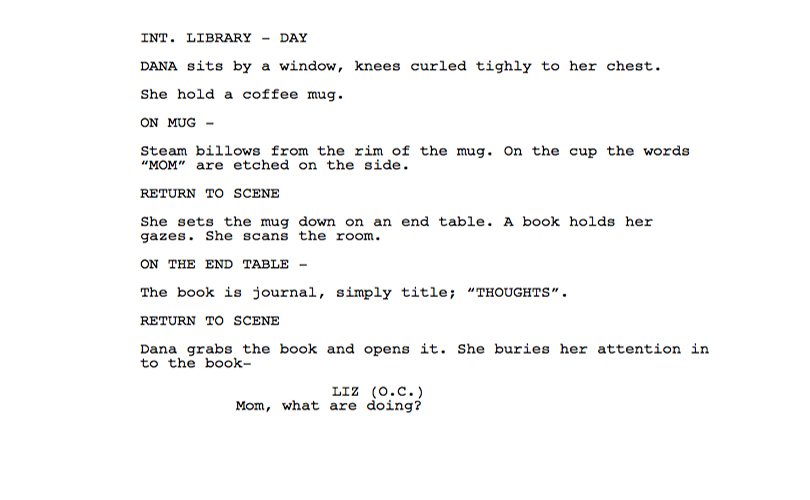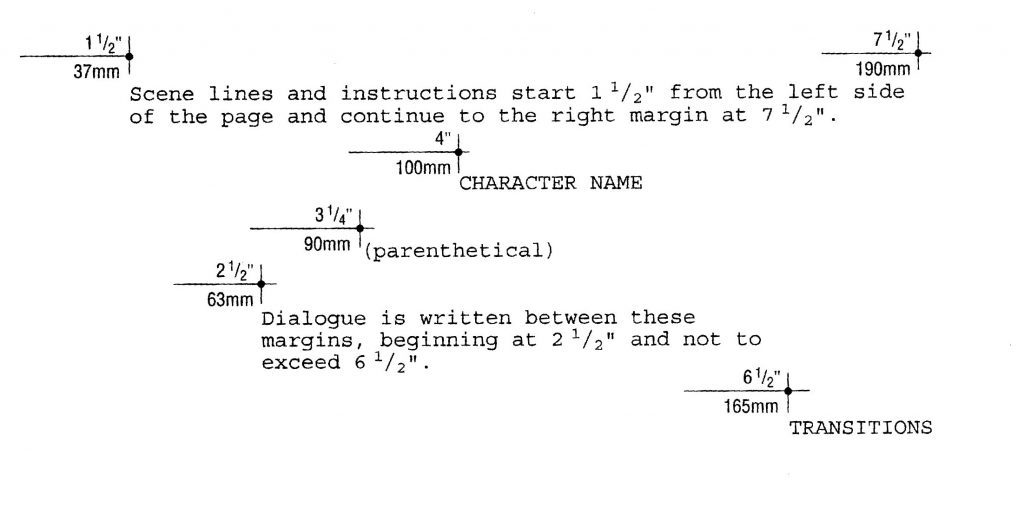Writing a screenplay is tough business. There are a ton of rules & formatting guidelines to follow. Luckily, this shouldn’t scare you away from writing a screenplay. The basics are just the beginning. if this comprehensive guide on how to write a screenplay helps you, please share it.
Graciously, The Film Club of America has prepared a tip sheet for you with resources, a screenplay example, and overview an on how to write a screenplay. So, we did this to get you acquainted with the basic screenwriting fundamentals. With some screenwriting books and insider knowledge, you will be ready to finish a draft in no time- Software can help too.
THE BASICS
Screenplays are a specialty documents, written- in courier 12pt font on a standard sheet of 8 1/2″ x 11″ white three-hole punched paper.

What’s the deal with writing screenplays in courier font?
The secret is by using this particular font a producer can can figure out how long a scene will run in the movie. The formula is that; 1 formatted script page in Courier font equals roughly 1 minute of screen time.
Fortunately, there is no standard length for any particular screenplay, but on average- you want to shoot for page count between 90 and 120 pages.

What kind of ideas make a screenplay?
A screenplay can be an original story, or rooted in non-fiction.
So, you may base screenplays on books, news stories, plays, or fairy tales. Evermore, inspiration can come from anywhere. Simply, anything goes for the most part. There are no rules. That is to say, you can brainstorm screenplay ideas from virtually whatever you want.
“If you can dream it, you can do it.”
Walter Elias Disney
Although, you need to be cautious sourcing material that is protected under copyright laws. Normally, you’d inquire with the publisher or original creator of the piece of work you’d want to adapt before starting a screenplay that may be under copyright protection.
Therefore, doing so could save you a lot of time.
What is a screenplay?
Essentially, a screenplay is a an instruction manual for a film. On-set personnel (the technicians making the film) including the producer, director, production designer and actors execute the screenwriter’s vision using their individual skills.
Above all, a team makes a movie. The screenwriter should be in tune to each person’s contributions. Even more, the screenplay should demonstrate the writer’s understanding of the filmmaking process.
For instance, film is a visual medium. As a screenwriter, you must show what’s happening in your prose, and not tell what is happening. If you can grasp this concept, you know how to write a screenplay.
So, this alone is the most difficult fundamental for a new writer to understand.


Similarly, Lengthy monologues may work well for a stage drama, but it can easily ruin a screenplay. This is idea build a good script; write a story using nothing but the basic visuals cues in your prose. Brevity is king.
On the other hand, a character’s face can demonstrate major plot points. Alas, let’s take a look at what a screenplay looks like. This is the script for the movie “Get Out” by Jordan Peele. Click here to read it. Remember, this screenplay won the 2017 Academy Award for best original screenplay.
The 1st page of your screenplay.
There a bunch of screenwriting software to help you with formatting. With that said; we will touch base on the on the spacing standards.

Now, this next is loaded with information and tips about the different elements of the screenplay. This comprehensive guide is going to really get into the details of how to write a screenplay, as well as how to format a screenplay.
Take your time reading and reviewing the content. Also, take breaks. Remember, try to format your own screenplay in any word processor to get the hang of things.
Each scene, regardless if it is a new location or a repeated one, needs a scene line. The scene lines are also known as “slug lines.“
FORMATTING RULES
The slug line is;
- aligned between a margin of 1-1/2″ and 7-1/2″ from the left side of the page.
- separated from whatever is above or below it by a single spaced line.
- typed in ALL CAPS
- should take no more than a single line.
Each slug line has three parts:
- staging
- location
- time of day
[/pt_vc_addon__text]
Actions are the instructions needed to communicate to cast and crew. The action block describes;
- characters who are present in the scene, how they are dressed and what they are doing in the scene.
- set decor & props which is unique to the narrative.
- blocking/actions that explain what happens to the characters when they are interacting with the scene’s environment and other characters.
- sounds other than dialogue that may be needed (phones, alarms, footsteps, etc.)
Ultimately, you’ll keep the action blocks short. Moreover, try to use verbs that describe what your reader will see on the screen.
FORMATTING RULES
Action blocks are;
- aligned between the 1-1/2″ and 7-1/2″ page margins.
- written in standard prose (sentences or fragments) with correct punctuation.
- compose in block paragraphs of 1-4 sentences, separated by single spaced lines.
[/pt_vc_addon__text]
Characters are the easiest part to write in a screenplay. These simple tip apply;
- ALL character MUST be introduced in the instructions the 1st time they appear in the script.
- When they appear for the 1st time in your story, the characters name MUST be in ALL CAPS.
- After the first introduction of your character, their name can appear in Title Case.
EXAMPLE; Sitting at the table is ROGER BARRET, late 40's and very attractive, ...
Generally, you don’t need to get too particular with a character’s description. That is, unless it fits the needs for the story.
FORMATTING RULES
Character and their description go within the action blocks. Just remember the ALL CAPS rule. Especially, if your character is making their first appearance in the script.
[/pt_vc_addon__text]
The dialogue block only consist of three elements;
- The character name.
- What the character is saying (the actual dialogue).
- The parenthetical, which instructs how or whom to speaks the dialogue.
Remember, you must use basic language and prose. Do not overcomplicate your dialogue, unless the story you are writing requires you to (e.g. sci-fi)
FORMATTING RULES
- The Character’s Name Must be in all caps on the very first line of the dialogue block, with a 4 inch tab stop.
- The dialogue (what the character is saying) is indented between 2 1/2 inches and 6 1/2 inches from the left side of the page.
- Scene cues always follow the character’s name, in ALL CAPS. (voiceover, off screen, etc.)
[/pt_vc_addon__text]
The parenthetical give the reader specific information about how the dialogue is supposed to be performed. A parenthetical must be concise & direct. General uses of a parenthetical include;
- Who the character is talking to
(to Bill)
(into handset)
(to himself)
- a particular action that is to be performed.
(giving the middle finger)
(lighting a cigar)
- The emotion or physical cue behind the dialogue.
(softly)
(coughing)
(American Southern accent)
Remember, be concise. The parenthetical isn’t meant to be an extension of an action block. It is used to give the reader cues on how the dialogue is going to be performed on the screen.
FORMATTING RULES
- Placed them on their own separate line.
- They are indented 3-1/4 inch from the left side of the page.
- Enclose the parenthetical in parenthesis.
- Use fragments, not complete sentences.
- The parenthetical, normally, applies only to that dialogue that follows its use. Regionals dialects and accents are an exception.
[/pt_vc_addon__text]

